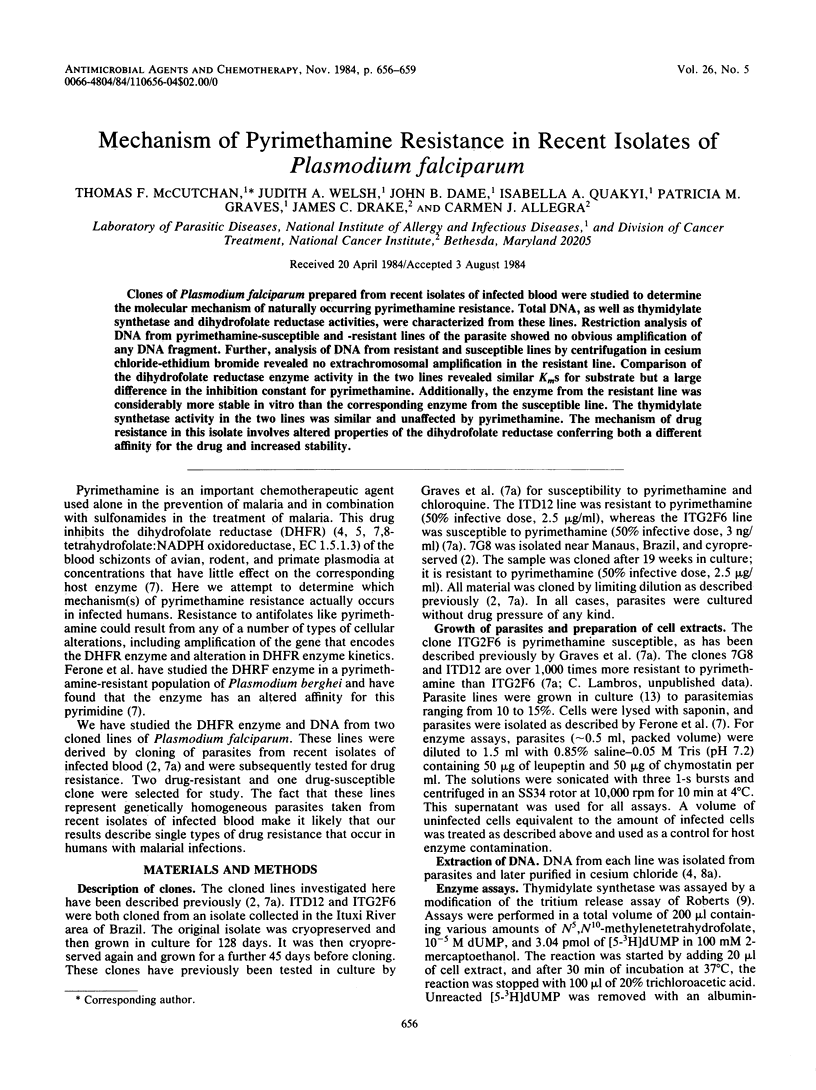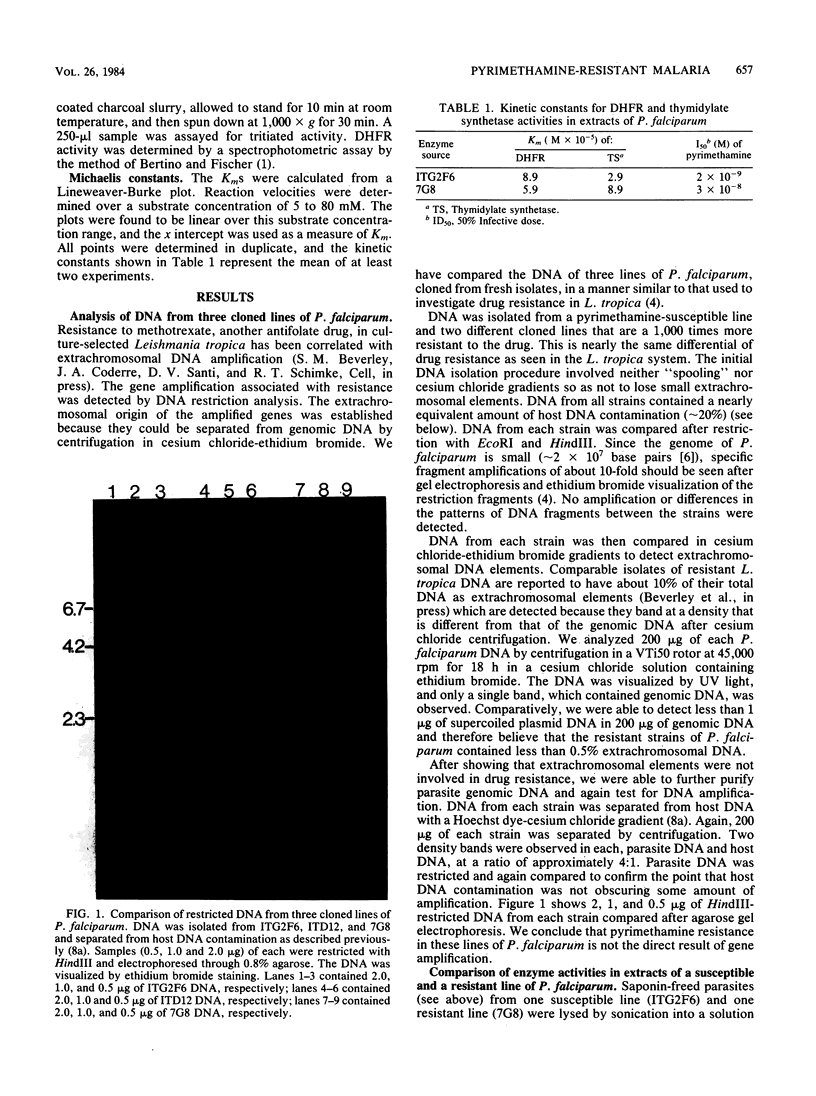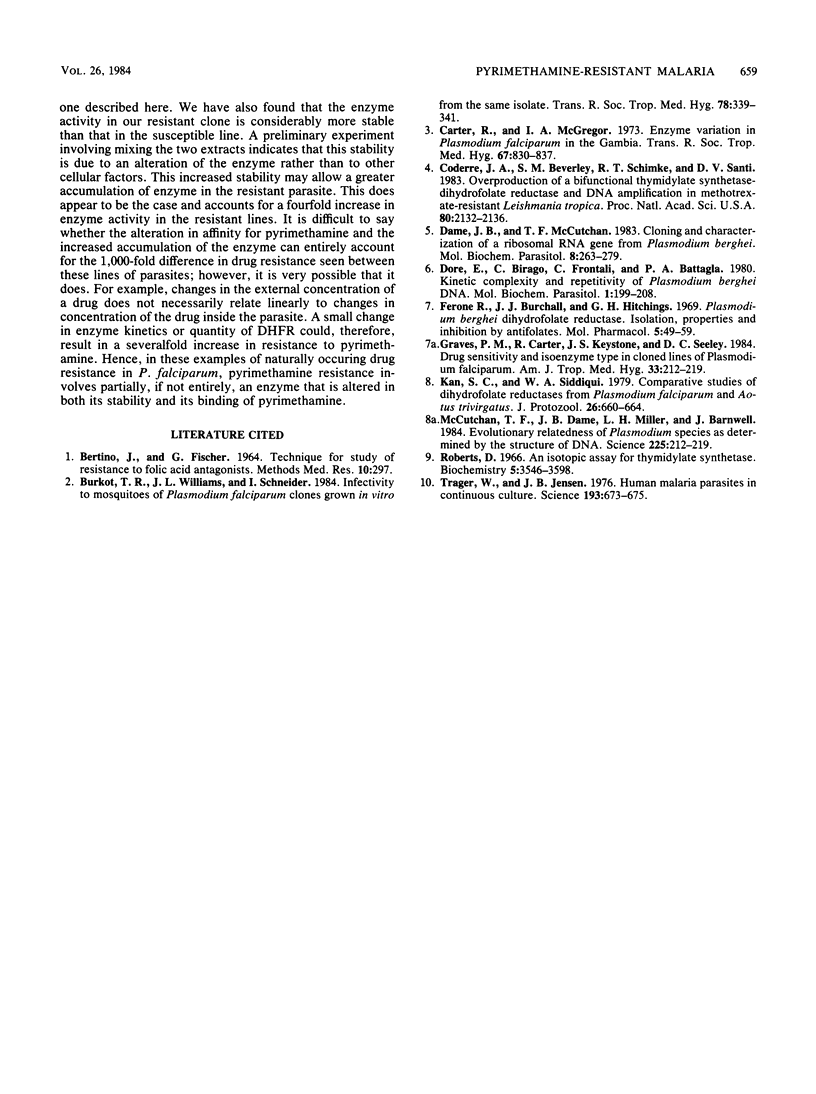Abstract
Clones of Plasmodium falciparum prepared from recent isolates of infected blood were studied to determine the molecular mechanism of naturally occurring pyrimethamine resistance. Total DNA, as well as thymidylate synthetase and dihydrofolate reductase activities, were characterized from these lines. Restriction analysis of DNA from pyrimethamine-susceptible and -resistant lines of the parasite showed no obvious amplification of any DNA fragment. Further, analysis of DNA from resistant and susceptible lines by centrifugation in cesium chloride-ethidium bromide revealed no extrachromosomal amplification in the resistant line. Comparison of the dihydrofolate reductase enzyme activity in the two lines revealed similar KmS for substrate but a large difference in the inhibition constant for pyrimethamine. Additionally, the enzyme from the resistant line was considerably more stable in vitro than the corresponding enzyme from the susceptible line. The thymidylate synthetase activity in the two lines was similar and unaffected by pyrimethamine. The mechanism of drug resistance in this isolate involves altered properties of the dihydrofolate reductase conferring both a different affinity for the drug and increased stability.
Full text
PDF



Images in this article
Selected References
These references are in PubMed. This may not be the complete list of references from this article.
- BERTINO J. R., FISCHER G. A. TECHNIQUES FOR STUDY OF RESISTANCE TO FOLIC ACID ANTAGONISTS. Methods Med Res. 1964;10:297–307. [PubMed] [Google Scholar]
- Burkot T. R., Williams J. L., Schneider I. Infectivity to mosquitoes of Plasmodium falciparum clones grown in vitro from the same isolate. Trans R Soc Trop Med Hyg. 1984;78(3):339–341. doi: 10.1016/0035-9203(84)90114-7. [DOI] [PubMed] [Google Scholar]
- Carter R., McGregor I. A. Enzyme variation in Plasmodium falciparum in the Gambia. Trans R Soc Trop Med Hyg. 1973;67(6):830–837. doi: 10.1016/0035-9203(73)90011-4. [DOI] [PubMed] [Google Scholar]
- Coderre J. A., Beverley S. M., Schimke R. T., Santi D. V. Overproduction of a bifunctional thymidylate synthetase-dihydrofolate reductase and DNA amplification in methotrexate-resistant Leishmania tropica. Proc Natl Acad Sci U S A. 1983 Apr;80(8):2132–2136. doi: 10.1073/pnas.80.8.2132. [DOI] [PMC free article] [PubMed] [Google Scholar]
- Dame J. B., McCutchan T. F. Cloning and characterization of a ribosomal RNA gene from Plasmodium berghei. Mol Biochem Parasitol. 1983 Jul;8(3):263–279. doi: 10.1016/0166-6851(83)90048-8. [DOI] [PubMed] [Google Scholar]
- Ferone R., Burchall J. J., Hitchings G. H. Plasmodium berghei dihydrofolate reductase. Isolation, properties, and inhibition by antifolates. Mol Pharmacol. 1969 Jan;5(1):49–59. [PubMed] [Google Scholar]
- Graves P. M., Carter R., Keystone J. S., Seeley D. C., Jr Drug sensitivity and isoenzyme type in cloned lines of Plasmodium falciparum. Am J Trop Med Hyg. 1984 Mar;33(2):212–219. doi: 10.4269/ajtmh.1984.33.212. [DOI] [PubMed] [Google Scholar]
- Kan S. C., Siddiqui W. A. Comparative studies on dihydrofolate reductases from Plasmodium falciparum and Aotus trivirgatus. J Protozool. 1979 Nov;26(4):660–664. doi: 10.1111/j.1550-7408.1979.tb04216.x. [DOI] [PubMed] [Google Scholar]
- Reschke M. F., Anderson D. J., Homick J. L. Vestibulospinal reflexes as a function of microgravity. Science. 1984 Jul 13;225(4658):212–214. doi: 10.1126/science.6729475. [DOI] [PubMed] [Google Scholar]
- Roberts D. An isotopic assay for thymidylate synthetase. Biochemistry. 1966 Nov;5(11):3546–3548. doi: 10.1021/bi00875a022. [DOI] [PubMed] [Google Scholar]
- Trager W., Jensen J. B. Human malaria parasites in continuous culture. Science. 1976 Aug 20;193(4254):673–675. doi: 10.1126/science.781840. [DOI] [PubMed] [Google Scholar]



